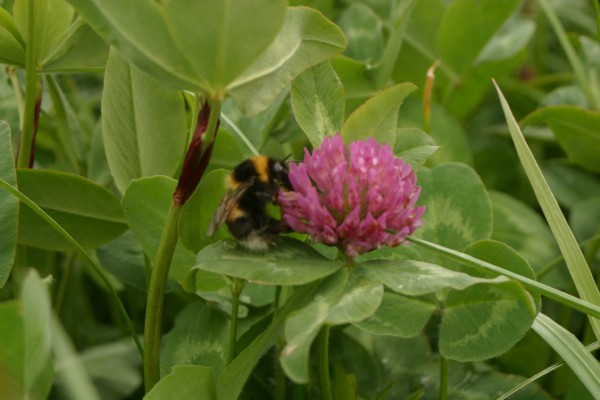

Better off Red
The main advantages of red clover are:
- at 20% crude protein it is superior to grasses in nutritional value and has a high voluntary intake by animals, the net affect of which leads to enhanced animal performance.
- grows on most soils.
- ability to ‘fix’ atmospheric nitrogen in the root nodules
- tolerance to winter cold and, due to its deep rooting characteristic, drought.
- suitability as a break crop to improve soil structure and fertility.
Varieties
Red clovers can be broken down into two distinct types: early and late flowering. There is a difference of around 10-14 days between the two, with the earlier types flowering in England at the end of May. Early flowering varieties have two main growth flushes during the growing season and start growth in spring earlier than late flowering varieties.
The late types produce more of their annual yield at the main first growth flush and are more persistent. Most of the varieties currently available on the market were bred many years ago when much more red clover seed was used in seed mixtures than now. However, there are breeding programmes in some European countries including at the Institute of Biological, Environmental and Rural Sciences (IBERS), Aberystwyth.
Increased resistance to clover rot disease and to stem eelworm has been a notable achievement by plant breeders. In recent years, varieties with improved production and persistence have been released from Switzerland. Milvus is one such variety. Interestingly, in an attempt to improve the tolerance of red clover to grazing, varieties with stoloniferous growth habits are being developed in Australia and New Zealand.
Seed Mixtures
For silage, red clover can be sown in monoculture at 5-6 kg/acre, but a mixture with grasses is preferable since this gives higher total forage yield and makes better silage. Mixtures of 9kg/acre grasses and 3 kg/acre red clover are commonly sown to provide the correct balance of grass to clover. For production over two years an excellent component is Italian ryegrass, but for over three years a mixture of hybrid and perennial ryegrass is a better option. To allow full expression of the red clover, it is best to use tetraploid varieties of the ryegrass since they tiller less densely than diploids. Their early-season ear emergence patterns should also coincide with the flowering pattern of the red clover. They are then at the same stage of maturity, and hence digestibility is similar.
Establishment
For sound establishment, a wellcultivated, firm and level seedbed is needed to ensure that the small clover seeds with their limited food reserves are drilled uniformly at a shallow depth of 10-15 mm. This chart below shows why sowing depth is critical.
|
Depth of Sowing |
% Seed Germination | |
| Clover | Ryegrass | |
| 1 | 81 | 94 |
| 2 | 63 | 95 |
| 3 | 21 | 86 |
| 4 | 12 | 68 |
Source: ITEB and EDE
The use of a roller prior to and after sowing is highly recommended. A well distributed establishment with approximately 200 plants/m² promotes a red clover-rich sward and is also a safeguard against the natural decline of red clover plants as the stand ages. The competitiveness of red clover against weeds is low at the early establishment phase particularly if sown alone. Topping is of value and ‘clover-safe’ herbicides are available, though they can check red clover development to some degree.
Sowing red clover directly in the spring gives greater yields of forage during the establishment year and following full harvest year than late-season sowings. Forage yields in the establishment year of spring sown swards is circa 60 per cent of that possible in the first harvest year. Red clover mixtures can be undersown in an arable silage crop, or after a cereal grain crop provided there is enough time for the plants to develop sufficiently prior to winter cold.
Feeding Value
Red clover is highly acceptable to livestock whether as hay, silage or when grazed at a young leafy-growth stage. In common with other forage legumes, it has a higher voluntary intake than grasses because of the low structural fibre to soluble plant cell content ratio. There is also a quicker breakdown of consumed forage and a faster clearance of particles from the rumen because of the physical structure of the leaves. The net influence of these characteristics is improved performance in dairy cows, beef cattle and sheep.
Place in Rotation
When red clover was at the height of its popularity thirty years ago, some farms had a problem with clover sickness. This was a combination of sclerotinia and stem eelworm, both soil-borne. There are some varietal differences with the cultivar Milvus thought to be the most resistant, but to avoid this problem altogether a five year gap should be allowed between leys containing red clover.
Oestrogen & Livestock Fertility
Red clover contains oestrogen which causes concern to livestock breeders if red clover is fed to females at or around conception. In practise this is avoided by not grazing high clover swards or feeding red clover silage at around conception time. For further information please ring for advice.
Date Posted: 30th March 2017



